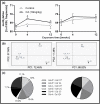Low levels of Cd induce persisting epigenetic modifications and acclimation mechanisms in the earthworm Lumbricus terrestris
- PMID: 28426746
- PMCID: PMC5398608
- DOI: 10.1371/journal.pone.0176047
Low levels of Cd induce persisting epigenetic modifications and acclimation mechanisms in the earthworm Lumbricus terrestris
Abstract
Toxic effects of cadmium (Cd), a common soil pollutant, are still not very well understood, particularly in regard to its epigenetic impact. Therefore, the aim of this study was to assess DNA methylation changes and their persistence in the earthworm Lumbricus terrestris upon chronic low dose Cd exposure using methylation sensitive amplification polymorphism (MSAP). Moreover, the biomarker response and fitness of the earthworms, as well as the expression of detoxification-related genes (metallothionein (MT) and phytochelatin synthase (PCS)) was evaluated. Low levels of Cd caused an increase in genome-wide DNA methylation, which remained partly modified, even after several months of recovery in unpolluted soil. Increased cellular stress seemed to decrease after two weeks of exposure whereas fitness parameters remained unaffected by Cd, probably as a result from the activation of detoxification mechanisms like the expression of MTs. Interestingly, even though the level of Cd exposure was very low, MT expression levels indicate the development of acclimation mechanisms. Taken together, this study demonstrates that acclimation, as well as epigenetic modifications can occur already in moderately polluted environments. In addition, these effects can have long-lasting impacts on key species of soil invertebrates and might persist long after the actual heavy metal challenge has passed.
Conflict of interest statement
Figures





Similar articles
-
Common mechanisms cannot explain time- and dose-dependent DNA methylation changes in earthworms exposed to cadmium.Sci Total Environ. 2022 Mar 15;812:151468. doi: 10.1016/j.scitotenv.2021.151468. Epub 2021 Nov 4. Sci Total Environ. 2022. PMID: 34742794
-
Species-specific Cd-detoxification mechanisms in lumbricid earthworms Eisenia andrei, Eisenia fetida and their hybrids.Ecotoxicol Environ Saf. 2021 Jan 15;208:111425. doi: 10.1016/j.ecoenv.2020.111425. Epub 2020 Oct 15. Ecotoxicol Environ Saf. 2021. PMID: 33068978
-
Rank-based biomarker index to assess cadmium ecotoxicity on the earthworm Eisenia andrei.Chemosphere. 2016 Feb;145:480-6. doi: 10.1016/j.chemosphere.2015.11.077. Epub 2015 Dec 13. Chemosphere. 2016. PMID: 26694799
-
[Metal-mediated Epigenetic Regulation of Gene Expression].Yakugaku Zasshi. 2017;137(3):273-279. doi: 10.1248/yakushi.16-00230-4. Yakugaku Zasshi. 2017. PMID: 28250320 Review. Japanese.
-
Cadmium and its epigenetic effects.Curr Med Chem. 2012;19(16):2611-20. doi: 10.2174/092986712800492913. Curr Med Chem. 2012. PMID: 22471978 Review.
Cited by
-
Environmental Epigenetics in Soil Ecosystems: Earthworms as Model Organisms.Toxics. 2022 Jul 20;10(7):406. doi: 10.3390/toxics10070406. Toxics. 2022. PMID: 35878310 Free PMC article. Review.
-
Cadmium, Smoking, and Human Blood DNA Methylation Profiles in Adults from the Strong Heart Study.Environ Health Perspect. 2020 Jun;128(6):67005. doi: 10.1289/EHP6345. Epub 2020 Jun 2. Environ Health Perspect. 2020. PMID: 32484362 Free PMC article.
-
High-level dietary cadmium exposure is associated with global DNA hypermethylation in the gastropod hepatopancreas.PLoS One. 2017 Sep 6;12(9):e0184221. doi: 10.1371/journal.pone.0184221. eCollection 2017. PLoS One. 2017. PMID: 28877233 Free PMC article.
-
Wound healing and Cadmium detoxification in the earthworm Lumbricus terrestris - a potential case for coelomocytes?Front Immunol. 2023 Dec 5;14:1272191. doi: 10.3389/fimmu.2023.1272191. eCollection 2023. Front Immunol. 2023. PMID: 38116011 Free PMC article.
-
Exposure to cadmium and copper triggers cytotoxic effects and epigenetic changes in human colorectal carcinoma HT-29 cells.Exp Ther Med. 2021 Jan;21(1):100. doi: 10.3892/etm.2020.9532. Epub 2020 Nov 26. Exp Ther Med. 2021. PMID: 33363611 Free PMC article.
References
-
- Järup L, Akesson A. Current status of cadmium as an environmental health problem. Toxicol Appl Pharmacol. 2009;238: 201–8. doi: 10.1016/j.taap.2009.04.020 - DOI - PubMed
-
- Waisberg M, Joseph P, Hale B, Beyersmann D. Molecular and cellular mechanisms of cadmium carcinogenesis. Toxicology. 2003;192: 95–117. - PubMed
-
- Fuller-Espie SL, Bearoff FM, Minutillo MA. Exposure of coelomocytes from the earthworm Eisenia hortensis to Cu, Cd, and dimethylbenz[a]anthracene: An in vitro study examining reactive oxygen species production and immune response inhibition. Pedobiologia (Jena). 2011;54: S31–S36.
-
- Žaltauskaitė J, Sodienė I. Effects of cadmium and lead on the life-cycle parameters of juvenile earthworm Eisenia fetida. Ecotoxicol Environ Saf. 2014;103: 9–16. doi: 10.1016/j.ecoenv.2014.01.036 - DOI - PubMed
MeSH terms
Substances
LinkOut - more resources
Full Text Sources
Other Literature Sources

